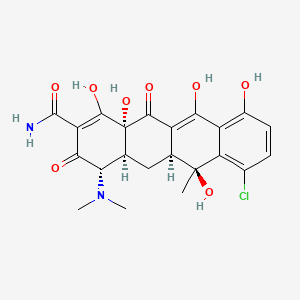| MeSH term | MeSH ID | Detail |
|---|---|---|
| Dermatitis Herpetiformis | D003874 | 1 associated lipids |
| Pneumonia of Swine, Mycoplasmal | D045729 | 2 associated lipids |
| Salmonella Food Poisoning | D012478 | 2 associated lipids |
| Dry Socket | D004368 | 3 associated lipids |
| Epidermolysis Bullosa | D004820 | 3 associated lipids |
| Testicular Hydrocele | D006848 | 3 associated lipids |
| Treponemal Infections | D014211 | 3 associated lipids |
| Digital Dermatitis | D058066 | 3 associated lipids |
| Subacute Sclerosing Panencephalitis | D013344 | 3 associated lipids |
| Anaplasmosis | D000712 | 3 associated lipids |
chlortetracycline
chlortetracycline is a lipid of Polyketides (PK) class. Chlortetracycline is associated with abnormalities such as Granulomatous Disease, Chronic, Infection, Ischemia, Cerebral Ischemia and Cerebral Infarction. The involved functions are known as Regulation, Binding (Molecular Function), Agent, Stimulus and Process. Chlortetracycline often locates in Protoplasm, Plasma membrane, Membrane, Cytoplasm and specific granule. The associated genes with chlortetracycline are FPR1 gene, P4HTM gene, Homologous Gene, HIST1H1C gene and Microbiome. The related lipids are Lysophosphatidylcholines, Sterols, dilauroyl lecithin, seminolipid and Total cholesterol. The related experimental models are Mouse Model.
Cross Reference
Introduction
To understand associated biological information of chlortetracycline, we collected biological information of abnormalities, associated pathways, cellular/molecular locations, biological functions, related genes/proteins, lipids and common seen animal/experimental models with organized paragraphs from literatures.
What diseases are associated with chlortetracycline?
chlortetracycline is suspected in Ischemia, Cerebral Ischemia, Cerebral Infarction, Granulomatous Disease, Chronic, Infection, Antibiotic resistant infection and other diseases in descending order of the highest number of associated sentences.
Related references are mostly published in these journals:
| Disease | Cross reference | Weighted score | Related literature |
|---|
Possible diseases from mapped MeSH terms on references
We collected disease MeSH terms mapped to the references associated with chlortetracycline
PubChem Associated disorders and diseases
What pathways are associated with chlortetracycline
There are no associated biomedical information in the current reference collection.
PubChem Biomolecular Interactions and Pathways
Link to PubChem Biomolecular Interactions and PathwaysWhat cellular locations are associated with chlortetracycline?
Visualization in cellular structure
Associated locations are in red color. Not associated locations are in black.
Related references are published most in these journals:
| Location | Cross reference | Weighted score | Related literatures |
|---|
What functions are associated with chlortetracycline?
Related references are published most in these journals:
| Function | Cross reference | Weighted score | Related literatures |
|---|
What lipids are associated with chlortetracycline?
Related references are published most in these journals:
| Lipid concept | Cross reference | Weighted score | Related literatures |
|---|
What genes are associated with chlortetracycline?
Related references are published most in these journals:
| Gene | Cross reference | Weighted score | Related literatures |
|---|
What common seen animal models are associated with chlortetracycline?
Mouse Model
Mouse Model are used in the study 'Chlortetracycline and demeclocycline inhibit calpains and protect mouse neurons against glutamate toxicity and cerebral ischemia.' (Jiang SX et al., 2005).
Related references are published most in these journals:
| Model | Cross reference | Weighted score | Related literatures |
|---|
NCBI Entrez Crosslinks
All references with chlortetracycline
Download all related citations| Authors | Title | Published | Journal | PubMed Link |
|---|---|---|---|---|
| Bowman SM et al. | Toxicity and reductions in intracellular calcium levels following uptake of a tetracycline antibiotic in Arabidopsis. | 2011 | Environ. Sci. Technol. | pmid:21882870 |
| Dong XF et al. | Effects of dietary polysavone (Alfalfa extract) and chlortetracycline supplementation on antioxidation and meat quality in broiler chickens. | 2011 | Br. Poult. Sci. | pmid:21732875 |
| Chander Y et al. | Identification of the tet(B) resistance gene in Streptococcus suis. | 2011 | Vet. J. | pmid:20696603 |
| Xie X et al. | Physiological and potential genetic toxicity of chlortetracycline as an emerging pollutant in wheat (Triticum aestivum L.). | 2010 | Environ. Toxicol. Chem. | pmid:20821522 |
| Spisso BF et al. | Pilot survey of commercial pasteurized milk consumed in the metropolitan area of Rio de Janeiro, Brazil, for tetracyclines residues, including the 4-epimers of oxytetracycline, tetracycline and chlortetracycline. | 2010 | Food Addit Contam Part B Surveill | pmid:24779621 |
| Stone JJ et al. | Tylosin and chlortetracycline effects during swine manure digestion: influence of sodium azide. | 2010 | Bioresour. Technol. | pmid:20728345 |
| Guillot M et al. | Dietary chlortetracycline induces differential effects on the accuracy of quantitative computed tomography and dual energy X-ray absorptiometry in assessing vertebral bone mineral density in growing pigs. | 2010 | Vet. J. | pmid:19501002 |
| Reinbold JB et al. | The efficacy of three chlortetracycline regimens in the treatment of persistent Anaplasma marginale infection. | 2010 | Vet. Microbiol. | pmid:20346598 |
| Chen WR and Huang CH | Adsorption and transformation of tetracycline antibiotics with aluminum oxide. | 2010 | Chemosphere | pmid:20378149 |
| Cornick NA | Tylosin and chlorotetracycline decrease the duration of fecal shedding of E. coli O157:H7 by swine. | 2010 | Vet. Microbiol. | pmid:20018464 |
